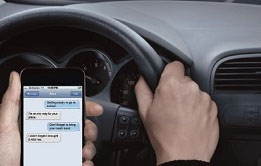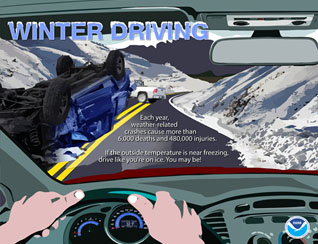Oil and Gas Well Drilling and Servicing eTool
Transportation » Transporting Personnel
Driving or riding in a vehicle is the most hazardous activity in the oil and gas industry. When transporting personnel, we are transporting the most valuable and fragile resource that we have. Personnel can be transported in a variety of vehicle types, including cars, pickups, crew vans, and buses.
The following section reviews some of the most likely hazards that could be encountered during the transporting of personnel and possible solutions for those hazards.
Potential Hazard
- Lack of pre-trip planning can result in lack of hazard identification.
Possible Solutions
- Conduct pre-trip planning with risk assessment and transport-related job safety analysis (JSA).
- Implement journey management. This is a strategy to reduce the total number of miles driven and the risks of road travel. Companies can manage journeys better when they systematically question the need for trips and select the safest routes, driving conditions, drivers, and vehicles.
- Use a GPS or smart phone for traffic updates and directions before departing and during the trip.

Potential Hazard
- Distracted driving involves anything that can take the driver's attention away from the task of driving, no matter how briefly. This includes things that take your eyes off the road, activities that take your hands off the wheel, or anything that takes your mind off driving. The NHTSA estimates that distractions are the cause of up to 20% of all crashes. Distractions can include slowing down to look at other crashes (rubber necking), reading, talking or texting on a cell phone, dwelling on personal problems, reaching for a fallen object, eating, looking too long at passing scenery, personal grooming, attending to children, adjusting the radio or controls, and excessive talking with other passengers.
Possible Solutions
- Implement safety policies that prohibit some of these activities. For example:
- Do not allow texting while driving. Download apps that prevent receiving and sending text messages.
- Do not allow phone conversations while driving.
- Use an in-vehicle monitoring system (IVMS) to analyze possible poor driving habits due to distractions.
- Implement vehicle safety programs and employee training.
- Include journey planning and management in safety programs and policies.
Potential Hazard
- Driving while sick or fatigued can result in a loss of attention or control, or actually falling asleep at the wheel. This is a potential hazard both on-duty and off-duty, particularly if planning to drive following a full work shift. In the oil patch it is not uncommon for workers to work back-to-back shifts, or until the job is done (e.g., a logging and perforating company is tasked to make multiple perforating and logging runs into the well. Prior to completion, technical difficulties are encountered. As a result, the job is completed 30 hours after it begins). These long hours can affect workers when they drive from the well site back to their shop or home.
Possible Solutions
- Implement fatigue management programs, including understanding of personal circadian rhythms and recognition/treatment of sleep disorders.
- Limit working hours and respect DOT Hours of Service rules.
- Utilize journey management techniques.
- Use dedicated crew buses so operators do not have to drive after a work shift.
- Stress the use of STOP WORK authority when a worker is too sick or fatigued to drive. This may require installation of rest quarters at the site.
- Identify available hotels or other rest options before driving.
Incident Examples:
When reviewing these incidents consider which of the Possible Solutions listed above could have prevented the incident.

- A school bus was attempting to make a right turn into an RV park and had to stop in its lane of travel to wait for another vehicle to exit the RV park. A van, carrying seven oilfield workers returning from a hydraulic fracturing operation, struck the bus from behind. The impact caused the van to roll. The driver and two passengers were killed in the crash. None of the fatally injured workers were wearing seatbelts. The other four passengers were taken to area hospitals. The officer’s crash report indicated that driver fatigue may have contributed to the crash. There were no brake marks at the scene and the crew was returning from a 24-hour-long shift.
- A worker employed by a company specializing in assembling well-control equipment was driving on a rural two-lane highway in a single-unit truck (25,960 lbs. RGVW). The driver was either fatigued or asleep, causing the truck to drift off the right side of the road and into a concrete culvert and a delineator that was in the bar ditch. This caused the truck to overturn and strike a wire fence. The driver was partially ejected during the crash and later died at the hospital. The driver was not wearing a seatbelt.
- An oilfield worker and a passenger in a pickup truck were approaching a right turn on a rural two-lane highway during the late morning. Instead of following the curve, the driver continued straight, veering into the opposite lane of traffic, and off the roadway. Once off the roadway the truck hit head first into the far side of a concrete culvert, causing the vehicle to flip and hit a utility pole. The driver died on scene and the passenger was transported to the hospital. Both the driver and passenger were wearing seat belts. Driver fatigue was noted as a contributing factor on the crash report.
Potential Hazard
- The use of drugs or alcohol before or while driving can result in loss of coordination or attention, and reduced motor skills that decrease reaction time. This can also be true if taking some prescription drugs, even at the recommended dosage.
Possible Solutions
- Include awareness training on the hazards of drug and alcohol use and driving.
- Review possible situations where prescription drugs and over-the-counter drugs should not be used.
- Implement drug/alcohol and substance abuse policies.
Incident Examples
When reviewing these incidents consider which of the Possible Solutions listed above could have prevented the incident.
- During the afternoon, two workers were hauling a trailer pulled by a pickup truck (20,900 lbs. combined GVWR) for a roustabout company. While on a rural two-lane highway the vehicles veered off the edge of the pavement. The driver over-corrected causing the vehicles to skid into the oncoming lane and off the side of the road where the vehicles struck a vent pipe and utility pole. Both the driver and passenger were not wearing seatbelts and were ejected. The driver was unlicensed, tested positive for methamphetamine, and had a blood alcohol concentration of 0.245. It was the crash investigator's opinion that intoxication due to drugs and alcohol was the primary cause of this crash.
- A worker for a well servicing company was approaching a stop sign at a T- intersection in a single-unit truck (26,000 lbs. GMVR) where the road he was travelling on was ending. The truck driver disregarded the stop sign and continued straight, striking a cattle guard. He then struck a dirt bank and the truck went airborne. The truck landed upright with the front of the vehicle striking the ground first. The driver was pronounced dead on scene. He was not wearing a seatbelt and had a blood alcohol level of 0.268.
Potential Hazard
- Inclement weather (snow, ice, heavy rain, fog) and poor road conditions (potholes, poorly maintained unsurfaced roads, unexpected obstacles) can increase driving risk.
Possible Solutions
- Implement journey management and trip planning programs.
- Train drivers on specific road types and weather conditions they might encounter (e.g. winter driving).
- Limit driving during poor weather.
- Avoid poorly maintained roads.
- Select the most suitable vehicle for the conditions/road.
- Use a GPS or smart phone for traffic updates and directions before departing and during the trip.
- Obtain weather forecasts for the planned travel.
- Use STOP WORK authority if inclement weather is forecasted/encountered.
- Identify available rest areas or lodging along the route if inclement or severe weather is forecasted/encountered.

Incident Examples
When reviewing these incidents consider which of the Possible Solutions listed above could have prevented the incident.
- Two workers were on their way home after completing a casing job. Heavy rainfall caused flash flooding in the area and their vehicle was unable to cross an intersection due to high water. Both workers exited the vehicle to climb to safety and wait for help. After leaving the vehicle one of the workers went missing and was later found deceased by law enforcement. The other worker was able to climb to safety. Flooding in this area stranded more than 100 oilfield workers.
- A worker was hauling waste water from a natural gas drilling site. While travelling at a slow speed, he attempted to descend a steep, snowy hill. The truck slid to the left side of the road, hit a ditch and continued to slide, running over the driver as he exited the truck. He was pronounced dead at the scene. Several other water trucks were reportedly unable to climb the hill that the worker was descending.
Potential Hazard
- Driving too fast for conditions or driving in excess of posted speed limits can greatly increase driving risk.
Possible Solutions
- Use In-Vehicle Monitoring Systems (IVMS) to modify driver behaviors.
- Include training on appropriate speed for road conditions.
- Establish driver counseling and disciplinary procedures.
- Set work schedules and planning to allow employees to respect speed limits.
- Periodically check drivers’ records for infractions (commercial and non-commercial).
- Use a GPS or smart phone for directions and estimated travel times before departing and during the trip.
Incident Example
When reviewing this incident consider which of the Possible Solutions listed above could have prevented the incident.
- A water tank truck driver lost control on a curve. The truck traveled into the opposite lane where it began to roll. The tanker then hit another vehicle and continued to roll over a hillside where it hit a residential garage. The truck driver was fatally injured. Residents reported that several crashes have occurred at this location in the past.
Potential Hazard

- Failure to wear seat belts significantly increases the possibility of injury or death in an accident.
Possible Solutions
- Use an In-Vehicle Monitoring System (IVMS) to track/report on seat belt use.
- Offer a driver training program.
- Establish seat belt policies/procedures as part of journey management procedures.
- Monitor seat belt use.
Incident Example:
When reviewing this incident consider which of the Possible Solutions listed above could have prevented the incident.
- Four workers in a pickup truck were driving on a two-lane blacktop paved road traveling home after their shift. It was night and the road was wet. The driver approached a left-hand curve at an unsafe speed and failed to negotiate the curve. The truck went into a skid and onto the unimproved shoulder, rolled over five times, and came to rest in an upright position off the roadway. The driver and one of the rear passengers were ejected as the truck rolled over and they were killed. Only one person out of the four was wearing a seat belt. The speed limit on the curve was 40 mph (dry conditions), and the truck was determined to have been traveling at 47 mph.
Potential Hazard
- Improper or lack of vehicle maintenance can contribute to mechanical failure and loss of control while driving.
Possible Solutions
- Establish a preventative maintenance program for all vehicles.
- Require drivers to inspect vehicles before use (both commercial and non-commercial vehicles).
- Consider use of a vehicle maintenance tracking program.
- Consider the use of a discrepancy reporting program for vehicle maintenance issues.
Incident Example:
When reviewing this incident consider which of the Possible Solutions listed above could have prevented the incident.
- A bulldozer operator stopped the vehicle on an uphill slope. When he exited the cab, the bulldozer’s parking brake disengaged causing it to roll back down the incline. The worker was fatally struck and pinned beneath the bulldozer.
Potential Hazard
- Other drivers and/or heavy traffic can challenge safe driving and create unpredictable, hazardous situations.
Possible Solutions
- Implement defensive driver training programs.
- Use journey management to minimize trips and vehicles on the roads.
- Time trips to avoid high traffic.
- Plan trips to avoid congested areas and times.
Incident Example:
When reviewing this incident consider which of the Possible Solutions listed above could have prevented the incident.
- A pickup truck traveling north hit a guardrail and then travelled into the southbound lane. The truck then struck a southbound van head-on that was carrying five oilfield workers. The collision caused the van to travel into the northbound lane and roll onto its side. The front seat passenger in the van, who was wearing a seat belt, was declared dead at the scene. Two other workers with serious injuries were transported to the hospital. The driver of the pickup truck had fallen asleep at the wheel and was under the influence of cannabis, which may have contributed to the incident.

Potential Hazard
- Driving in darkness limits visibility, raising the level of driving risk. Low-beam headlights limit visibility to about 250 feet and high-beams limit visibility to about 500 feet. Depth perception, color recognition and peripheral vision can be compromised in the dark. The glare of headlights from oncoming vehicles can also temporarily blind a driver.
Possible Solutions
- Use a journey management program to limit night driving.
- Maintain vehicles to ensure lights function properly.
- Train employees about reducing speed to avoid over-driving the reach of headlights (defensive driving).
Potential Hazard
- Wildlife strikes can result in major damage to vehicles, or more severe accidents if drivers attempt to avoid animals and lose control/leave the road.
Possible Solutions
- Use journey management to avoid times of day when wildlife is most active.
- Provide driver training.
- Stay extra-alert when driving in areas where wildlife are expected.
- Fit vehicles with “brush guard” type bumper systems and deer whistles.
Potential Hazard
- Loose objects in the vehicle become high-speed projectiles in the event of an accident.
Possible Solutions
- Perform a pre-trip check to ensure load securement.
- Secure heavy objects in the trunk of a car or bed of a pickup with cargo straps or tie-downs.
- Avoid loose objects in the cab that could interfere with vehicle operation or control.
Potential Hazard
- Road rage can quickly escalate, sometimes resulting in an accident or a physical altercation.
Possible Solutions
- Provide defensive driver training.
- Report aggressive drivers.
- Ensure drivers are trained to avoid actions that could exacerbate or escalate the situation.

